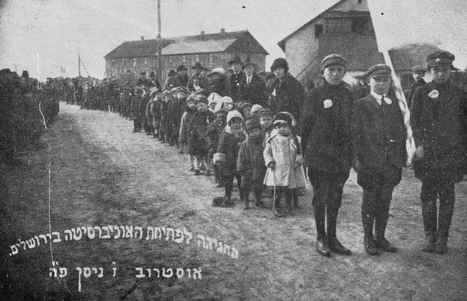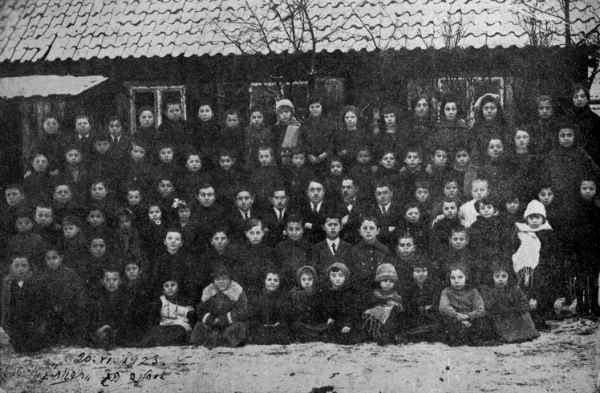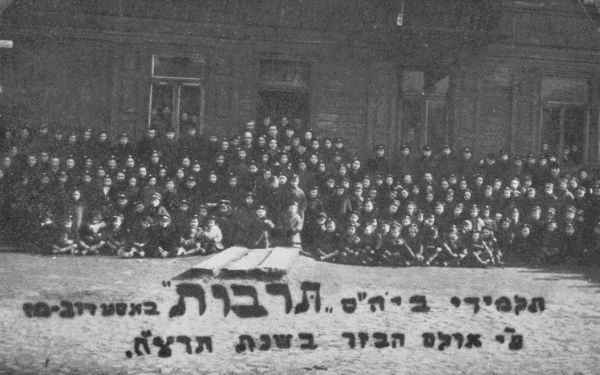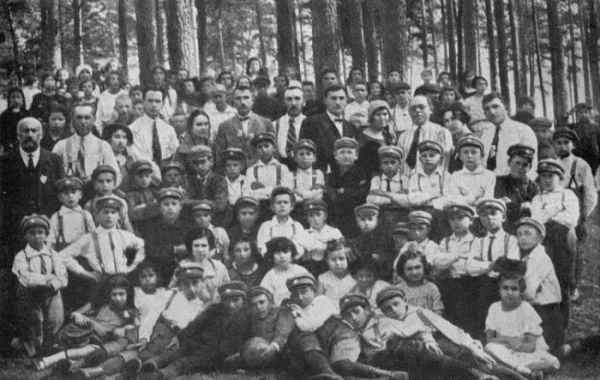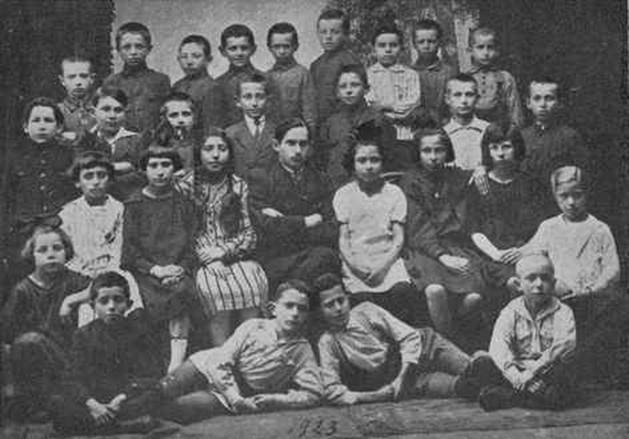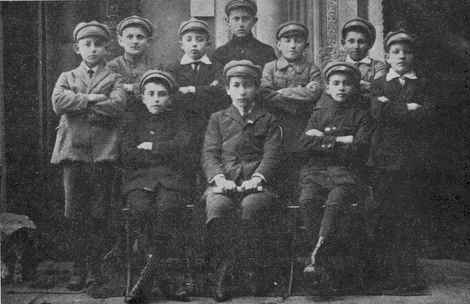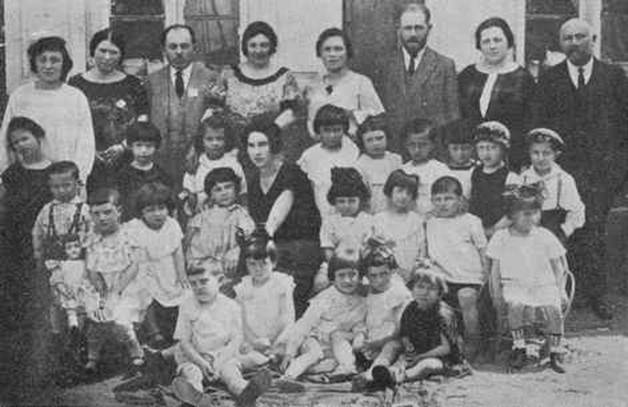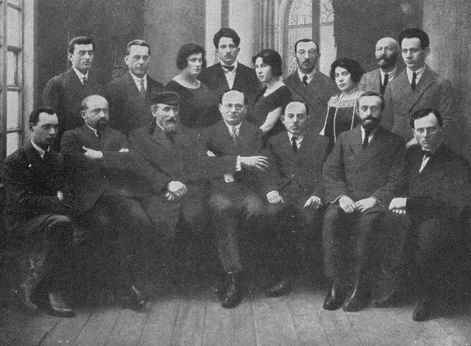Ostrów Mazowiecka
The “Tarbut” School in Ostrów Mazowiecka
By Icchok Shoshani (Rozenthal) Tel-Aviv
Translated by Ros Romem
For the school children of Ostrów Mazowiecka who
were taken from the land of the living at a tender age
together with all of Israel in Poland.
One bright, sunny day in April 1925 almost all the streets and lanes of town were empty. Big and small were walking on Warszawska Street towards something that had never been seen before in the streets of Ostrowa. Along the entire length of the marketplace and Warszawska Street a procession of school children marched holding little blue and white flags in their hands, accompanied by teachers, parents and other Jews wearing blue and white ribbons in their lapels. A big blue and white flag was carried at the head of the procession, and next to it a Polish flag. The boys and girls marching were students at the “Tarbut”elementary School, consisting of six grades, which had been founded three years earlier, in this town of Hasidim and Mitnagdim. The children of the “Tarbut” School had already learned Hebrew songs and they sang in the festive blue and white parade. The festive spring procession went along the length of Warszaska Street. Jews filling the sides of the street accompanied the procession with mixed feelings. Their eyes expressed curiosity, wonder and some disregard and scorn, but with pride and affection too. After the sadzawka the procession turned to the right onto the Rożan Highway and stopped at an empty lot opposite the Tejtel family's sawmill, next to the big, long wooden building in which the “Tarbut” School then held classes. At the end of the lot a stage decorated with greenery and national flags had been set up. Above it waved a banner on which was written a passage from Elijah the Prophet: “For from Zion will come the Torah and the word of the Lord from Jerusalem”.
From this stage speakers in Hebrew and Yiddish brought the great national cultural news about the festive opening of the first Hebrew University on Mount Scopus in Jerusalem to the Jewish community of Ostrowa. Several hundred schoolchildren who studied Hebrew along with the
|
|
“Tarbut” students parade for the opening of Hebrew University, Jerusalem |
adults sang Hatikva with enthusiasm and yearning. On that same clear spring day enthusiastic eyes caressed the wooden building of the “Tarbut” School and with longing, reflected on the monumental building of the Hebrew University on the postcards that were handed out to them. In their minds they saw the bridge connecting the “Tarbut”School in Ostrowa and the Mountains of Zion in Jerusalem. Hearts beat warmly and enthusiastically at the idea of the national rebirth. This large public celebration was an opportunity for the National Zionist camp to publicly demonstrate its achievements to the town. This celebration took place in honour of the opening of the Hebrew University in Jerusalem, but its focus was the “Tarbut” School .The fathers and mothers and Zionist Jews saw future students of the Hebrew University on Mount Scopus in the celebrating and singing children. Their radiant faces reflected their secret longing: “Our eyes will see thy return to Zion”. In Jewish Ostrowa this celebration echoed the joy of life and the hope of faith. This April celebration demonstrated the first summation and promised good fortune.
If between the two World Wars Ostrowa was famous throughout Poland as a vibrant and active city; and if during this time Zionist pioneer youth movements were established and developed which made a profound change to the face of the city; and if thousands of young people emigrated to the Land of Israel and integrated with the builders and protectors of the homeland - then all this was due to the Hebrew “Tarbut” School founded in 1922.
The above mentioned celebration took place on the empty lot adjacent to the long, two story wooden building, where the “Tarbut”School then functioned. In this unsuitable and ramshackle building this institution was created, step by step through hard work, persistence and devotion. This wooden building was actually the last structure in town on Rozan Highway. The area was non-Jewish. Jewish schoolchildren walked for kilometers to this area on the very edge of town, in rain and wind, in the snow and freezing cold. They came to learn Hebrew and to acquire an elementary education in this language. They came to draw from the source of Jewish treasures from the beginning of its existence, throughout all its generations to absorb the fervour and strength to achieve the return of Zion and the rebirth of the nation in their generation.
The site of the school was not accidental. It was somehow symbolic. The aspirations of the “Tarbut” movement and everything associated with it were connected to the upheaval of reality in Jewish Ostrowa. The establishment of the “Tarbut” School in Ostrów Mazowiecka in those days involved enormous difficulties. Besides the objective difficulties, the founders had to overcome all sorts of malicious interference and obstacles placed in their path by extremist, unenlightened and fanatical groups. The “Tarbut” School in Ostrów Mazowiecka was founded on the blessed initiative of a small group of parents, who were looking for a suitable educational framework for their children; a school which would answer all the requirements of a Jewish and a secular education, which would educate proud, nationalistic Jews.
In 1922, the year the “Tarbut” School was founded, Jewish children in Ostrowa studied in three types of schools. There was a government elementary school with seven grades. This school was for Jewish children only and they did not teach there on Saturday (Shabbat) but on Sundays. For some reason it was called in the gentile language “Szabsowka”. At first they taught only girls in this school. In later years they added boys but only a small number. As stated all the children in
|
|
“Tarbut” students 1923 |
|
|
Students in the Tarbut School in Ostrów Mazowiecka 5698 [1937-38] |
this school were Jewish. The teachers were also Jewish. Under these special circumstances the children did not suffer anti-Semitic persecution by teachers or classmates at school. (among the teachers at this Polish government school were some with Jewish nationalistic awareness and even active community workers, spokesmen and representatives of the Zionist and Zionist Socialist parties).
Under these lenient and convenient conditions all the Jewish parents found it possible to send their children (especially their daughters) to this school. Even the orthodox could not find an objection to sending their daughters to learn to write and also to do a little arithmetic. It could not hurt and it might even help in the future. The number of children in this school sometimes exceeded nine hundred and came close to one thousand. By the number of pupils, it was the largest school in town. The school was completely Polish in every respect. The curriculum was exactly the same as the government school for Polish children. The language of instruction was Polish, not a word of Yiddish, not a word of Hebrew. There was barely any Judaism. Once a week the pupils heard passages about Mosze Rabeinu [our master] Abraham Avinu [our patriarch] or the sacrifice of Isaak. If not for the absolute Jewish framework within which the Jews lived in Ostrowa, this education would have led to assimilation. This danger, in the degree that it existed, mainly concerned the girls. The town was mainly Mitnagid and Hasidic. They did not recognize the danger. What was the tragedy if girls were educated in Polish? Later these groups established an evening school for girls, a “Beit Jakob”, to teach them something about Judaism and to educate them as proper daughters of Israel. This school was in addition to the Polish school and not in place of it. At “Beit Jakob” a small number of girls studied several times a week after the Polish government school hours. This is how the daughters of Israel were then taught and educated in Jewish Ostrowa.
The boys? The boys studied in heder with teachers after the old, ancient style: the alphabet, siddur, prayers, Khumash and Rashi, Mishnayes. Gemara, with Tosefus, etc,etc.
After some years a concentrated public heder, “Yesodei HaTorah” was established on ulica Batorego. The children at “Yesodei HaTorah” were classed by their knowledge and placed in heder 1, 2, 3 and so on up to 8. A number of classrooms in the “Yesodei HaTorah” building were given to the Talmud Torah where children of poor parents, unable to pay school fees, studied. The teachers at “Yesodei Hatorah” and the Talmud Torah were the same teachers who taught in the private heder.
Then Heder HaKloli was established to replace the other two (in the same building which years before had held a yeshiva then “Yesodei HaTorah” and Talmud Torah). Superficially, one could see the influence of the modern schools on the Heder HaKloli. Instead of tables and stools, the narrow benches used in the Polish schools were introduced into the classrooms. There was a special table for the teacher, a blackboard and chalk, pens and ink wells for writing and a class attendance book in which the pupils were marked present or absent.
Later teachers who taught how to write an address in Polish on an envelope were also introduced into the Heder HaKloli. These Polish teachers were Jewish students in the senior class at the local Polish gymnazia. They taught in the afternoon after finishing for the day at the gymnazia and some were former gymnazia students who had interrupted their studies for various reasons.
Later the influence of the Tarbut was felt on this Heder HaKloli and teachers who taught a little Hebrew were also accepted. The writer of this article filled this position for a short time. But some of the parents were dissatisfied with the heder's old-fashioned style of teaching and especially with the curriculum.
After the First World War, from 1918 to1920, new winds of progress began blowing, even in Ostrowa. The Balfour Declaration, the British mandate for the Land of Israel, the awakening and the battle of the Jewish community for independent political and national activity was exciting and encouraging. The fear of the old-fashioned heder increased and heightened. Fathers began to look into books that were not religious, read newspapers and travel to big cities. They saw and fell victim to education, the yearning to study and gain knowledge. Broad horizons opened as well for the fathers of Jewish children in Ostrowa and they began to plan for their children's futures. On no account would they leave their children in the old educational ghetto. They sensed and felt, more than they understood intellectually, that they must allow something more extensive to broaden the minds of their children than was provided by the heder; something more open to the world at large – secular education. This area had not yet been completely revolutionized, but corrections, changes and improvements were being demanded.
Young educated yeshiva students who also thought this way helped the move in this direction. As a result of all these opinions and combined wishes the heder metukan was established, which when opened was the old heder but modernized. The yeshiva students opened modern hederim in their homes. The external appearance of this modern heder was like that of the old, but the content changed somewhat. In addition to religious studies that had filled all the long hours in the old heder, they now also taught writing in the modern heder – Hebrew writing. Arithmetic was also taught. Several modern hederim existed in Ostrowa. In the early twenties there were three choices of education for Jewish children in Ostrowa - the Polish government public school mainly for girls, the old-fashioned heder and the modern heder. Did all these fill the needs for educating and enlightening Jewish Child? The founding of the coed Hebrew school Tarbut showed that the answer was obviously no.
In 1921 several families with school age children came to live in Ostrowa. Some were political refugees from the Soviet Union and others were from nearby small towns. Among the latter were also those who moved to the district town in search of a suitable education for their children. They immediately turned to the modern heder. This modern educational institution was somewhat of a disappointment. It did not take long before these parents were convinced that this was not what they were looking for, that this was not what they had in mind.
News of Hebrew secular elementary schools call “Tarbut” was making its way from larger towns, especially from Lithuanian Poland and from the eastern parts of the country. Ostrowa was ripe for an attempt to establish such a school. There were people who would take up the challenge with persistence and give it their heart and soul.
And these people were also found. The main reason for their taking on this blessed and difficult initiative was their own children. In their opinion no school in town met their requirements for their children. So, such a school needed to be established, to be created from nothing. The three founders of the “Tarbut” School were Fiszel Rozental (the writer's father), Mendel Wszawer and Jakob Perec. Later Mosze Jeruchim and others joined them.
The writer of this article came to Ostrowa with his family when he was seven years old and before he had learned what an alef [Hebrew letter – “a” in English] looked like. Because of me, my family moved to Ostrowa. On arrival I went to study at the heder metukan under the Wolomyner (Plocker). But in my father's opinion the lessons were not what he expected
|
|
Teachers and students “Tarbut” School, Lag b'Omer field trip 5685 (1925) |
|
|
Third grade Tarbut students 1922/23 with teacher Rozenfeld in the middle |
|
|
Student committee – Tarbut School |
He did not like the program. He worried and thought and considered and contemplated and decided to found the “Tarbut” School. He went and started it together with the two Jews mentioned above and for many years carried the heavy burden of the school. He did not let his livelihood or family suffer. Difficulties and struggles did not deter him. He was completely devoted to the establishment and maintenance of the “Tarbut” School in its first and very difficult years.
Those three Jews discussed and conferred and got to work getting things done. In the beginning there were twenty children in the house where the Dmoch family lived, on the street of the Financial Fund, in Jakob Perec's yard. Previously Dmoch had his heder metuken there and the unused study benches still stood in the back room. Dmoch had moved to America and his family remained behind for a while, as was done in those days.
The rented the room and the benches from the “American woman” Dmoch and in addition her three sons became pupils. The first teacher was Ezra Jeruchim, the son of Mosze the glazier, an educated young man who knew Hebrew. It started off well. Parents began inquiring about this experiment. The number of students increased.
Later they rented the vacant building of the “Ochronka” on the lane opposite the Russian Orthodox Church. It had a lot of rooms with school benches. It was here that the first four grades were started. At first the Polish authorities tried to interfere and make things difficult. However the “Tarbut” headquarters in Warszawa provided the necessary help to overcome these difficulties. When about five hundred boys and girls were registered at the “Tarbut” School, they were seen about town wearing their official, shiny, lacquered, peak caps of blue and white stripes, with a Magen David [star of David] and the “Tarbut” insignia in the center, like…the gentiles. Then orthodox groups began to seriously interfere, starting a religious war against the school. The dues for the school were expensive for the parents. The school had to support itself from these scholastic fees without any other financial aid. Nevertheless parents from all strata swarmed to enroll their children because there was a lot of support for the school. Because the school was called “Tarbut” – its opponents found a useful passage and called it “Tarbut Anashim Chatayim” [the culture of sinners]. They spoke disparagingly about the boys and girls aged eight to ten, calling them “corrupt young men and virgins together”. And about teaching Hebrew as an everyday language – desecrating the Holy tongue. The culmination of their campaign against the school was a visit by three renowned rabbis who came with the clear intention of destroying what had been built with so much hard work and effort.
The visit by the rabbis had an effect. Hundreds of parents were deterred. And from the five hundred pupils enrolled, only one hundred remained to continue their studies. The parents' committee known as “corturion” had to face a bitter battle and even their livelihoods were in jeopardy. The school was in danger of being closed in its first year. However the insistence, persistence and dedication of the volunteers enabled them to overcome all these difficulties and obstacles. And the “Tarbut” School stabilized and remained on a path of slow, sure development in all areas – until it became the crown of the educational institutions in town, becoming fertile ground for the glorious growth of the Zionist pioneer youth movements such as Hashomer HaTsair, Hashomer HaLeumi and others.
The language of instruction at the “Tarbut” school was Hebrew. All subjects were taught in Hebrew: mathematics, science, nature, history, geography and all the rest. Naturally, a great deal of attention was given to Judaic subjects: to Hebrew – the language and literature and the history of the Jewish people. After regular school hours, mishnah and talmud were also taught.
Literature, history, geography and Polish were taught according to the official curriculum in the government elementary schools. In the two top grades of the school, which had seven grades, German and English were also taught.
The curriculum was varied and complicated. It was not easy for the students or the teachers. In addition, suitable schoolbooks in Hebrew were not available in all subjects. Often they studied in Hebrew from a Polish schoolbook. Finding qualified teachers was an even greater difficulty. Yet “Tarbut” headquarters helped considerably in these areas. The superintendent at “Tarbut” headquarters, Mr. Einstein, who guided the school with great devotion in it first years, became very emotionally attached to the school in Ostrowa. I began studying there in the second grade, when it was founded. I completed all seven grades and remember with appreciation, respect and awe the names of the following teachers: Rozenfeld, Wejgmajster, Zlotkes – for Polish; Berrenzon, Dubrowski – for mathematics; Frejd, nature and geography; Icchok Szumowicz, Zajfman and Finkielsztejn – tanakh, Hebrew and grammar. Szmul Ryba – talmud; M. Holcman – German and drawing; Szwarc (Balak) – English; Rywka Tiktyn – in the lower grades. And there were many more teachers to whom many hundreds of pupils are grateful for opening the gates of learning and knowledge for them and for starting them on the road to a life of national rebirth.
The “Tarbut” School also started a kindergarten. The first kindergarten teacher was Miss Weiner and she opened the first kindergarten in a house on the road to Zambrów, not far from the Church and there was even a piano there.
|
|
Kindergarten class with Miss Weiner (sitting in the centre) |
The “Tarbut” volunteers in Ostrowa were not satisfied with only giving the children an elementary education. They also established adult evening classes in Hebrew and for students at the Jewish Public [Government] School. They also took care of continuing Hebrew education and Jewish studies for children completing their elementary school. They contacted the famous Hebrew High School in Bialystok and an examining committee was sent every year to test the children finishing the school – with the goal that some of them would continue at the Bialystok Hebrew High School.
The first year that the committee, consisting of Mr Mosze Zabludowski and Dr Wolger, examined students was the year I completed seventh grade. The first group of graduates from the “Tarbut” School in Ostrowa who were admitted to the Bia³ystok Hebrew High School included: Jeszaja Estry, Dwojra Weber, Meier Wszawer, Szmul Fejgin and myself.
The high standards of the “Tarbut” School in Ostrowa, especially in the field of language, Hebrew literature and Jewish studies, was famous throughout the region and was especially appreciated by the teachers and pupils at the Bialystok Hebrew High School.
|
|
The “Cortorion” and teachers of the “Tarbut” School with Superintendent Einstein, in the centre |
If Ostrów Mazowiecka later became a Zionist town and its Zionist communal life served as a perfect example to others; if once without a pause in its pulse, the Zionist pioneer youth, organized in a variety of national pioneer youth movements, came to many hundred; if many of them now live in Israel and are creating a new historic chapter of the people that was reborn in its homeland; for all this we have largely to give great thanks to the “Tarbut” School, the principal and persistent founders who worked with such devotion for the community, to the devoted parents, dear pupils and fine teachers.
These paragraphs will be a memorial – a witness…for the generations, so that they will know and remember what took place, what is gone forever and will never exist there again. So they will know and remember that school children at the “Tarbut” School, parents, teachers and volunteers through persistent, boundless efforts played a large role in the Jewish national revival which brought us to the establishment of Israel, our homeland.
